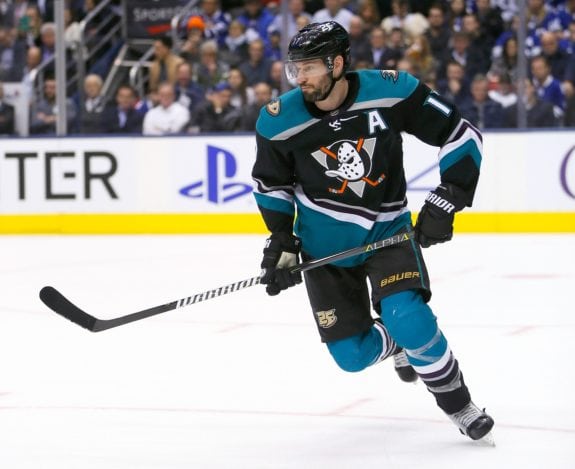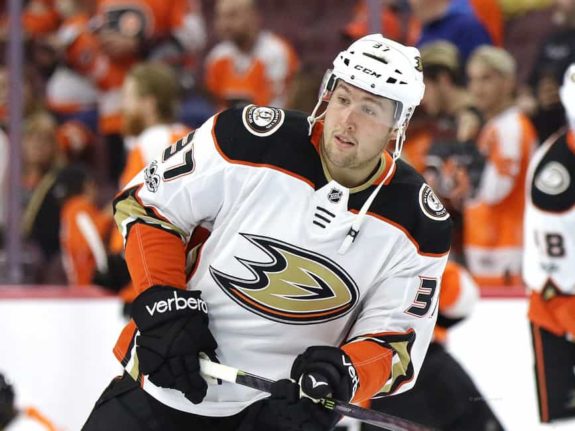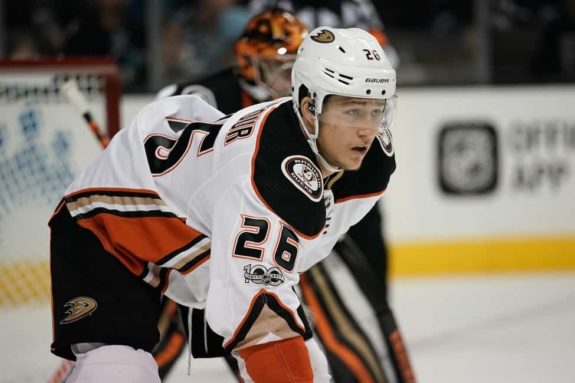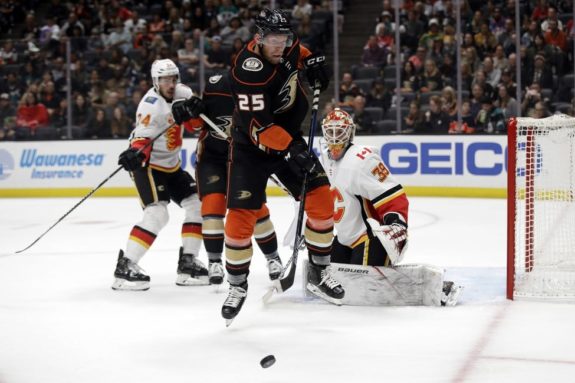A lot has changed since 2014. Barack Obama was still president of the United States, Connor McDavid was still playing for the Erie Otters and the Anaheim Ducks were still a Stanley Cup contender. With nearly six years of hindsight, it’s been long enough that the Ducks 2014 NHL Draft can be analyzed to measure the effect it had on the team and its future. Four of the Ducks’ five picks that draft played a significant number of NHL games for the team, yet the only one who is still Ducks property is somehow only a junior in college. Let’s take a look at the 2014 draft and see the effect it had on the franchise.
The Price of Contending
In 2014, the Ducks were a contender and had been nearly every season since winning the Stanley Cup in 2007. As a result, general manager Bob Murray and the Ducks were buyers in 2013 and 2014 and made numerous moves to improve the team. That included blockbusters like the Ryan Kesler and Bobby Ryan trades, which rearranged their draft assets significantly.
The Ducks made five selections in the 2014 Draft thanks to Murray’s itchy trade trigger finger. That included the draft-day trade that brought Kesler and a 2015 third-round pick to Anaheim in exchange for Nick Bonino and Luca Sbisa, as well as the Ducks’ 2014 first and third-round picks.
Related: 2014 NHL Draft Rankings
Despite trading away their first and third-round picks, the Ducks still had the No. 10 overall pick they acquired for trading Bobby Ryan to the Ottawa Senators. They also had two second-round picks, one which they received from the Toronto Maple Leafs and one of their own, in addition to a fifth and seventh-round pick.

Anaheim made only a single selection using one of their own draft picks, having acquired the other four picks in trades, including multiple picks they’d sent away in earlier trades.
No. 10 Overall: Nick Ritchie
The book has closed on Nick Ritchie’s story in Anaheim. After more than five full seasons as Ducks’ property and three full seasons playing for them, Ritchie landed with the Boston Bruins at the 2020 deadline in exchange for Danton Heinen.
Ritchie started his Ducks career by teasing fans’ appetite for the next franchise player to aid Ryan Getzlaf and Corey Perry at the tail end of their careers. In 2016-17, his first full season with the Ducks, Ritchie scored 14 goals and added 14 assists in 77 games.
Related: Jean Beliveau, Miracle of Modesty
Unfortunately for Ritchie and Ducks, he never eclipsed that number again and only topped those 28 points once, when he scored nine goals and tallied 22 assists in 2018-19.
The time he spent in the penalty box compounded the frustration that he couldn’t seem to reach his potential. Instead of decreasing his penalty minutes, they rose. In 2018-19, Ritchie ranked No. 17 in the league, with 82 penalty minutes.
This season, through 46 games played in Anaheim and Boston, he ranks No. 8 in the league, with 82 penalty minutes.
The Beginning of the End
Ritchie held out for a new contract to start the 2018-19 season, missing nine games before returning, which likely didn’t endear him to his general manager. Still, he lasted more than a full calendar year longer with the Ducks before Murray sent him to Boston. Though Heinen’s performance in Anaheim will ultimately write the final chapter in Ritchie’s story with the Ducks, his time on their roster was disappointing, especially considering names that were still on the board after the Ducks drafted him in 2014.

While it is a bit unfair to look back and criticize a general manager for not accurately predicting the future, it is still a fun exercise in what could’ve been. By drafting Ritchie No. 10 overall, the Ducks missed an opportunity to select Jakub Vrana, Dylan Larkin and David Pastrnak who were still all available at that spot.
No. 38 Overall: Marcus Pettersson
Murray and the Ducks drafted Marcus Pettersson in the second round, No. 38 overall in 2014. Thanks to converting from a forward to a defenseman, Pettersson had above-average offensive instincts to go with a 6-foot-3 frame, but needed some work on the defensive side of his game.
The Swedish defender spent three full seasons after the Ducks drafted him playing in the Swedish Hockey League before joining Dallas Eakins and the San Diego Gulls in 2017-18.
Related: Top 10 NHL Goalie Prospects
Pettersson made his NHL debut for the Ducks on Feb. 15 of that same season before scoring his first NHL goal on March 4 versus the Chicago Blackhawks.
Pettersson spent most of that season on the third pairing with some second-unit power play minutes mixed in. Things looked promising for the young Swede heading into the next season when he made the Ducks out of training camp.
Unfortunately, things changed quickly. On Dec. 3, 2018, the Ducks traded Pettersson to the Pittsburgh Penguins in exchange for Daniel Sprong. Sprong’s skill set made him an attractive player for the Ducks, but he never panned out and landed with the Washington Capitals at the 2020 trade deadline for Christian Djoos, another Swedish defender.
Meanwhile, Pettersson has spent time playing on the Penguins’ second pairing, averaging more than 17 minutes per game the past two seasons. Though he is a left-shot defender, considering the Ducks’ injury issues at the position and who they ended up with after the Sprong trade, it might have been worth holding onto Pettersson.
No. 55 Overall: Brandon Montour
If not for Ondrej Kase (I’ll get to him in a second), Brandon Montour would’ve been the Ducks’ best selection in the draft when they selected him No. 55 overall.
Montour had promising offensive skills for a defenseman that made him an attractive pick for a team that had already had success drafting offensive defensemen. He had elite skating ability and a strong shot from the point, which made him an asset on the power play.

Montour would spend one more season in the USHL, followed by one season with Umass-Amherst of the NCAA’s Hockey East Conference before turning pro at the end of 2014-15. He made his NHL debut in 2016-17, scoring two goals and adding four assists in 27 games. His breakout performance came in the 2017 playoffs when he contributed seven assists, helping the Ducks to the conference final.
Deadline Casualty
Like both players drafted before him in the 2014 Draft, Montour’s time with the Ducks ended by trade. At the 2019 trade deadline, Murray traded him to the Buffalo Sabres in exchange for Brendan Guhle and a conditional 2019 first-round puck that became Brayden Tracey.
Tracey has been more than a point-per-game player in his two full WHL seasons and made a strong impression at the Ducks’ Rookie Faceoff in the 2019-20 preseason.
Drafted the year following Montour, Guhle has also shown bouts of success in the NHL. He’s scored eight points in 29 total games with the Ducks this season and he’s shown an increased goal-scoring ability of late. He’s scored three goals in the 11 games since he last joined the Ducks.
No. 123 Overall: Matthew Berkovitz
At the start of last season, if someone had asked you, “Who will be the only player the Ducks drafted in 2014, that’s still in the organization at the end of next season?” would you have said Matthew Berkovitz?
Probably not.
Even more astounding is that Berkovitz, who was 18 in 2014, is still only a JUNIOR IN COLLEGE! What?
It’s true. Berkovitz is at the tail end of his junior season at the United States Military Academy, where he committed after decommitting from Wisconsin. The 6-foot-1, left-shot defender is now 24, with a goal and five assists on the blue line for Army.
Now that the Trump administration has allowed athletes who compete for the nation’s military academies to defer their service to pursue a professional career, Berkovitz could theoretically turn pro.
It remains to be seen if Berkovitz will turn pro after he finishes at Army, but he’s not likely to play for the Ducks any time soon, if at all.
Berkovitz was considered a bit of a project coming out of high school in Wisconsin when he was drafted near the top of the fifth round but had promising skating ability and size. Considering he may not turn pro until seven years after the Ducks drafted him, he probably isn’t much of a factor in their future.
No. 205 Overall: Ondrej Kase
Kase was one of the steals of the 2014 NHL Draft. Not only did he go in the seventh round, but he was also five picks from being the last player to hear his name called. Nearly six years later, if the 2014 Draft were redone, he’d probably go at the end of the first round.

He might be one of the best value picks the Ducks ever made. Like nearly every other player the Ducks drafted in 2014, he’s now playing for another NHL team after Murray included him in the David Backes trade at the 2020 trade deadline.
Kase may have had one of the more perplexing draft falls of all time, having been ranked eighth among European Skaters by the NHL’s Central Scouting Bureau. From the looks of things, his lack of physicality and size contributed to his fall down the draft.
After the Ducks drafted him, Kase made it clear the Ducks had been smart to select him. The season following his draft he spent playing in his home country of the Czech Republic before signing his entry-level contract in May 2015.
Kase spent barely 18 months in the AHL before making his NHL debut on Nov. 2, 2016. He scored his first goal Dec. 1 versus the Vancouver Canucks. He finished that season with 15 points before breaking out in 2017-18, scoring 20 goals and adding 18 assists for the Ducks.
Another Duck in Boston
Unfortunately, injury issues and inconsistency derailed his career in Anaheim, and he wound up in Boston in the Backes trade. Kase’s impact on the Ducks will not be fully realized until the team makes the first-round pick they got from the Bruins for trading him to Boston.
Legacy of the 2014 Draft
The Ducks were relatively productive in 2014 in terms of finding NHL players. However, although Ritchie and Kase both teased fans and media with promising starts to their careers, neither followed up their early success up to the expectations they created for themselves. Meanwhile, they also drafted two NHL defensemen that they traded away — one, Montour, could’ve helped their struggling offense from the right side of the blue line this season.
As recently as three years ago, these players appeared to be a strong supporting cast for a competitive team. Unfortunately, their inability to realize their full potential, especially for Kase and Ritchie, is part of the reason they are now on other teams and the Ducks are where they are today — in a rebuild.